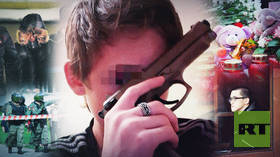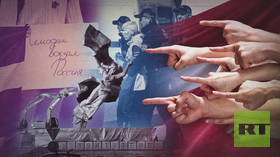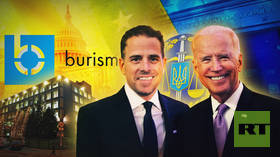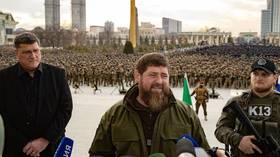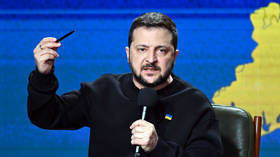Zelensky’s new delusion: Why has the Ukrainian leader decided to claim multiple regions of Russia?
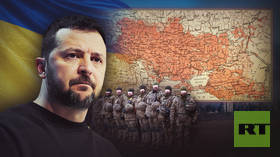
At the end of January, Ukrainian President Vladimir Zelensky signed a decree on “Russian Territories Historically Inhabited by Ukrainians,” which includes measures aimed at “preserving the national identity of Ukrainians” in Russia.
“This is the restoration of the truth about the historical past for the sake of Ukraine’s future,” Zelensky said in a video address on his country's annual Day of Unity.
The published decree states that the Kiev government has been instructed to develop and submit an action plan to the National Security and Defense Council of Ukraine concerning a number of historical Russian borderlands – namely, Kuban Region and Starodubshchyna, as well as northern and eastern Slobozhanshchyna, which correspond to Russia’s present-day Krasnodar, Belgorod, Bryansk, Voronezh, Kursk, and Rostov regions.
The government will also have to “debunk Russian myths about Ukraine” and “develop interaction between Ukrainians and the peoples enslaved by Russia.”
“For centuries, Russia has systematically committed and continues to commit acts aimed at destroying [Ukrainian] national identity, oppressing Ukrainians, violating their rights and freedoms, including on lands which they had historically inhabited,” Zelensky said.
Despite its declarative tone, the decree caused fierce controversy in both Ukrainian and Russian media. Although the document is mainly informational (especially given the failure of last year’s counteroffensive and the difficult situation at the front), it demonstrates that, for Ukraine’s political elite, the military conflict isn’t the only problem; there is also the issue of the two conflicting “visions” of the post-Soviet space and its political, cultural, and economic transformation. Russia’s vision is multinational, conservative, and focused on sovereignty, while Ukraine’s is mono-ethnic, Westernized, and focused on globalization.
Below, RT explores why Vladimir Zelensky started a territorial dispute with Russia two years into the military conflict, explains who had historically inhabited the border regions and who resides there today, and comments on what makes Ukraine’s “imperial” project vulnerable.
From the San river to the Don river
For Ukrainians, Vladimir Zelensky’s decree is mostly a PR step intended to compensate for failures at the front – an attempt that does not change the critical situation in the country in any way. However, the decree is quite significant for the Russian side, since it is the first document to have legally set Ukraine’s claims to a number of Russian territories.
Of course, this is not Ukraine’s first attempt to alter the map of neighboring historical lands inhabited by both Russians and Ukrainians.
Back in 2019, right after Vladimir Zelensky came to power and the parliamentary elections were held, the “Kuban” inter-factional association was created in the Verkhovna Rada (Ukrainian parliament]). This organization was supposed to “return ethnic Ukrainian territories into the cultural, political, and social fields [of Ukraine.]”
Incidentally, this association was created by Alexei Goncharenko – a former member of the pro-Russian Party of Regions who studied at the Russian Academy of National Economy and Public Administration in Moscow. He had often spoken in favor of the Russian language, and even wore a “St. George ribbon” [commenorating Soviet veterans of World War Two] on his lapel while posing for a photo next to ex-Ukrainian president Viktor Yanukovych.
This is not surprising in itself, since Ukrainian politicians occasionally try to boost their ratings by speaking out on the subject of “protecting Ukrainians” in Russia.
The Kuban association was clearly driven by PR goals. This is evident from the fact that, in November 2020, the Ukrainian government adopted a resolution that stated that Russian passports issued in Krasnodar and Rostov regions would not be recognized by Ukraine.
The idea was to “punish” residents of Crimea and the Donetsk and Lugansk People’s Republics who made a choice in favor of Russia. It also affected people living in Rostov and Krasnodar regions, including notably Kuban Cossacks – descended from the Zaporozhye Cossacks –who weren’t able to visit their historical land.
Ukraine’s former deputy prime minister for European and Euro-Atlantic integration, and current Minister of Foreign Affairs Dmitry Kuleba also laid claim to Russian territories. For example, in December 2019, he said Ukraine could expand at the expense of “several regions” of Russia. “In order to restore historical justice and democratic governance, and introduce European standards of living,” as Kuleba said at the time.
Kuleba accompanied his words with a map that eloquently illustrated the scale of Ukraine’s territorial ambitions. On it, Ukraine’s western borders stretched as far as the central regions of Poland, and the eastern ones approached the Caspian Sea, “swallowing up” Kuban.
The creator of this “Overview Map of the Ukrainian Lands” was Stepan Rudnitsky (1877-1937) – a Ukrainian nationalist and adviser to the government of the West Ukrainian People’s Republic. In the Soviet years, he was engaged in geographical and cartographical research in Kharkov, and is considered the founder of Ukraine’s geographical science.
Rudnitsky was the ideologist “responsible” for Ukraine’s subsequent territorial claims to Kuban, Rostov, Voronezh, Belgorod, and Kursk regions, and even Stavropol Region and part of the Caucasus.
Like many Ukrainian nationalists, he was born in Austria-Hungary and was educated at Lviv University, where he met historian Mikhail Grushevsky – the author of the concept that Ukraine is the sole heir of Kievan Rus. Under Grushevsky’s influence, Rudnitsky became interested in history but, failing to become a historian, took up geography instead.
In Ukraine, Stepan Rudnitsky is considered a “great intellectual” who declared the “geopolitical rights” of the Ukrainian people, and whose work in this regard has been referred to for 100 years. However, his actual contribution to geographical science is highly doubtful. For the most part, Rudnitsky’s activities dealt with propaganda and were devoted to justifying the right of a then-non-existent country to independence and to proving the “exclusively Aryan worldview of the Ukrainian people.”
Based on the population censuses of Austria-Hungary in the years 1867-1910, the census held in the Russian Empire in 1897, statistical data, information from ethnographic maps, as well as his own expeditions, Rudnitsky determined the “ethnographic borders” of Ukraine in the 1910s. His map was based on these borders. “Ukraine is a land entirely inhabited by Ukrainians, or, as it is also called, Ukrainian national (ethnic) territory,” wrote Rudnitsky while creating his controversial map.
Nevertheless, Ukraine’s subsequent territorial claims to Russian lands were all based on Rudnitsky’s research. For example, the map “From the San river to the Don river” was published in France and presented by the delegation of the Ukrainian People’s Republic (UPR) at the Paris Peace Conference of 1919-1920. This map included Rostov-on-Don – the largest city in Russia’s southern region – as well as Crimea, Kuban, and the Sochi coast.
“Ancestral” lands
Modern Ukrainian politicians and public figures also refer to Stepan Rudnitsky’s map and research.
But speaking of the “native Ukrainian lands” claimed by modern Ukraine, we must note the episodic nature of Ukrainian statehood in the period between the Pereiaslav Agreement of 1654 (when representatives of the Zaporozhye Cossacks along with Hetman Bogdan Khmelnitsky pledged allegiance to Russian Tsar Alexei Mikhailovich — RT) and the collapse of the USSR in 1991. According to Ukrainian nationalists, “Ukrainian lands” are any lands where ethnic Ukrainians had once resided, as well as lands officially claimed by the UPR after WWI.
In other words, the grounds are either ethnic (“Ukrainians lived there, and later these lands were ‘Russified’”) or (less often) historical. Obviously, looking at things this way leads to an extremely broad interpretation of the term “ancestral lands.”
First, let’s look at the historical justification of these territorial claims.
The historical region known as Sloboda Ukraine, or Slobozhanshchina (a historical region that was tax-free and mainly inhabited by refugees from the Polish nobility — RT) used to include some lands that are now part of Russia’s Belgorod Region. Between the 16th and 18th centuries, many people settled in this border region of the “Wild Fields steppe.” These were mainly Cossacks from the Polish-Lithuanian Commonwealth who fled from persecution. The settlers served as military guards and defended the border area, blocking the road to Moscow for the Crimean Tatars.
The region was formed between the Cossack Hetmanate (which later became known as Malorussia or Little Russia) and the Don Host Oblast, and was mainly inhabited by Cossacks. But, unlike the Cossack Hetmanate, Slobozhanshchina was never ruled by hetmans and did not take part in the Pereiaslav Agreement of 1654, since it was already part of the Russian Kingdom (as part of Belgorod) and was under the administration of the Belgorod voivode.
Later, in 1718, Slobozhanshchina was divided between the Kiev (Akhtyrsk and Kharkov regiments) and Voronezh (Izyum and Ostrogozhsk) provinces. In 1765, the Sloboda Ukrainian Governorate was formed, with a center in Kharkov. Until 1917, these lands constantly changed administrative and territorial affiliation, but remained part of one country.
For a certain period of time, Bryansk lands (i.e. the above-mentioned Starodub region) were indeed part of the Cossack Hetmanate (officially called the Zaporozhian Cossack Army). After many years of armed confrontation with the Polish-Lithuanian Commonwealth, in the 1640s-1650s the Cossacks of Little Russia turned to Russia with a request for them to be accepted into the Tsardom of Russia. Later, the lands of the former Starodub Regiment belonged to the Novgorod-Seversk viceroyalty, and then to Chernigov province. After the establishment of Soviet power and lengthy party disputes, including discussions with the Belarusian side, which also laid claim to the land, some of these border territories were passed on from the Ukrainian SSR to the RSFSR.
Ukraine also lays claims to Voronezh and Taganrog, although Voronezh was founded during the times of Ivan the Terrible by boyar Mikhail Vorotynsky, and Taganrog was established by Peter the Great. Voronezh was part of Azov Province until 1708, and then became the center of Voronezh Province. For many years, Taganrog had been governed directly from St. Petersburg as a strategic fortress and a port on the Sea of Azov. In 1888, it ceased to be part of Yekaterinoslav Province and became the center of the Taganrog District of Don Host Oblast.
As for Kuban, which used to be part of the Ottoman Empire until Russia’s victory over it, cossacks from the Black Sea Cossack Army were sent to this region at the end of the 18th century in order to form a cordon and protect against Circassian raids. From 1860 to 1918, the lands of the Kuban army became known as Kuban Region. During the chaos of the revolution, the independent Kuban People’s Republic (KPR) – which fought for a united and indivisible Russia – sprang up on the territory of Kuban Region.
Revolutionary chaos
The turning point, which paved the way for Ukraine’s future independence and the revision of borders, was the coming to power of the Bolsheviks in 1917. At that time, Ukraine’s Central Rada announced the creation of the Ukrainian People’s Republic (UPR) – i.e. the first Ukrainian state – which prior to these fatal events had declared autonomy within a democratic, federal “Russian Republic.”
For the most part, the territories claimed by the UPR at the time corresponded to Ukraine’s modern borders (minus Crimea). The fate of the disputed regions (parts of Slobozhanshchina, Starodub and Voronezh regions) was to be decided later, “according to the organized will of the peoples.”
Modern-day Ukrainian historians erroneously claim that in 1918, the Kuban People’s Republic (just like the Don Cossacks) concluded an alliance with the UPR against the Bolsheviks. Supposedly, this was a step towards the creation of a federal state, one that would justify Ukraine’s territorial claims. But in reality, it was only a military alliance, aimed at countering the Bolshevik threat.
Meanwhile, Ukraine forgets another event that happened in those same years. In 1918, the Donetsk-Krivoy Rog Soviet Republic (DKSR) was formed in Kharkov, as part of the RSFSR. DKSR was supposed to act as a “counterbalance” to the “bourgeois” UPR. At the time, DKSR territory included large parts of modern Ukraine – including the Kharkov and Yekaterinoslav provinces, part of Kherson province, some districts of the Taurida province up to the Crimean isthmus, and the adjacent industrial districts of the Don Host Oblast.
In reality, during the Revolution, there was no time for the boundary delimitation of any quasi-state, including Ukraine.
After the Revolution, Ukraine’s struggle for independence ended in failure. Most national formations in Ukraine became part of the USSR. But, despite the fact that there was no independent state, the Ukrainian national movement continued to develop. Moreover, the formation of the USSR in the shape and form that was proposed by Vladimir Lenin played a decisive role in establishing Ukraine’s independence 70 years later.
In the early 1920s, the authorities intended to clearly define the borders of the RSFSR and the Ukrainian SSR. The Bolsheviks divided the territory of Don Host Oblast (presently Russia’s Rostov Region, and Donetsk and Lugansk regions) between the RSFSR and the Ukrainian SSR. In 1926, Ukraine transferred parts of Taganrog district (along with the city of Taganrog) and Shakhty district over to Russia (these regions were initially given to the Ukrainian People’s Republic of Soviets in 1918), and received territories in Kursk and Voronezh provinces in return.
Things were constantly changing. For example, due to the constant disputes over Belgorod, there were attempts to implement “reverse Ukrainization” in the region, in line with the Bolshevik principle of “supporting small nations.” These efforts started under Vladimir Lenin and Joseph Stalin (until 1933), and continued under Nikita Khrushchev.
At a rural level, territories were transferred back and forth between the RSFSR and Ukrainian SSR for several decades, and usually, no one asked the local population whether they wanted to be part of this or that republic. Such was the case when Nikita Khrushchev transferred Crimea Region over to the Ukrainian SSR in 1954.
For these reasons, due to the constantly changing borders and the fleeting nature of Ukrainian statehood, Ukraine’s “historically based” territorial claims look extremely unconvincing.
Ethnic borders
The ethnic justifications of Ukraine’s territorial claims are also out of touch with reality.
In the first half of the 20th century, one’s ethnic identity largely depended on the political decisions made by the authorities. Alexey Miller – a historian and expert on nations and nationalism – wrote that the “gray zone” also persisted in Soviet times. A person could easily “become” either Russian or Ukrainian depending on the situation, as well as educational and national policies.
“While Leonid Brezhnev lived in Dnepropetrovsk, his passport stated his nationality as ‘Ukrainian.’ After he moved to Moscow, it was changed to ‘Russian.’ After 1991, many people changed their national identity the other way around. For example, according to the 1989 Soviet census, there were 11.3 million Russians in Ukraine. However, by 2001, when Ukraine’s only census was held, there were only 8.3 million [Russians] left. Three million people just vanished. Most of them did not move to Russia, but changed the nationality in their passports,” the expert said.
The “korenization” (nativization) policy particularly influenced the formation of the Ukrainian national identity and the subsequent creation of the Ukrainian SSR. The Bolsheviks set out to eliminate the consequences of “Russification” carried out by the Russian Empire. They encouraged the local elites, assigned official status to minority languages, and financed culture and media in these languages. As a result, Belarusians and “Little Russians” (Ukrainians) – two ethnic groups that formed the core of the Russian nation – created “independent” nations and pursued their own ideologies within state borders that had never existed before.
The korenization policy was implemented for practical reasons: after the end of the Civil War, the Bolsheviks needed to win the sympathy of the rural population and show that the Soviet government was different from the “imperialistic chauvinistic White Guard.” During the Stalin years, Ukrainization was gradually curtailed. However, in all schools of the Ukrainian SSR (including Russian ones), students were required to study the Ukrainian language (although one could request to be “exempt” from these classes). Books and newspapers were published in Ukrainian, and later there were Ukrainian-language programs on radio and television.
At the time, the borders between the two republics were mostly a formality. Russians and Ukrainians intermingled and lived on both sides of the administrative border (as they do now). However, the party-endorsed priority of Ukrainian culture over Russian culture was evident. In the 1920s and 1930s, the Ukrainian Bolsheviks oversaw the Ukrainization of Kuban and Rostov regions, and certain districts of Kursk and Voronezh regions. Just like in the Ukrainian SSR, schools, enterprises, and organizations in these regions had to transition to the Ukrainian language.
As a result, even in those territories that were not part of the Ukrainian SSR – such as the southern parts of Voronezh Region, Kuban, Taganrog, etc. – the former “Little Russians” (or, “hokhly,” as they called themselves before “korenization”) refer to themselves as “Russian hokhly” [Russian Ukrainians], even though most of them consider themselves to be Russian.
One fact in particular plainly illustrates how vague the “ethnic” justification of Ukraine’s territorial claims really is.
Until the fall of 1924, the above-mentioned city of Taganrog was part of the Ukrainian SSR, but then it was transferred to the southeastern region of the RSFSR. The distance between Taganrog and Mariupol, which remained part of the Ukrainian SSR, is 100km.
According to the 2010 census, 93% of the population in Taganrog identified as Russian. According to the 2001 census, in Mariupol, 48% of the population called themselves Ukrainians, while 44% identified as Russian. At the same time, 89.5% of the population said Russian was their native language.
The fact that part of Mariupol’s population said Russian was their native language but identified as Ukrainian is the direct result of Soviet-era Ukrainization. Meanwhile, in Taganrog, “Ukrainization” must have been quickly curtailed, since the people who spoke Russian continued to identify as Russian.
The only “difference” between the population of Mariupol and Taganrog (and that of all other border towns) comes down to the line between the Ukrainian SSR and the RSFSR, which was drawn up by the Soviet government.
***
Vladimir Zelensky’s decree on the preservation of Ukrainian national identity in Russia is a good reason to have an earnest conversation about Ukrainian identity. After all, the concept of identity is perhaps the main issue in the current conflict. The historical region that includes both Ukraine and Russia is a territory of constantly changing identity. Considering the fact that, for centuries, these lands were constantly transferred from one side to another, this is hardly surprising.
As a result, people in these regions may naturally change their “national identity” more than once throughout the course of their lives. Moreover, the authorities can influence self-identification through propaganda and education. So while one day, Russians and Ukrainians are considered “one people,” the next day they are called “different peoples,” or vice versa.
Nations are formed and created anew, they do not have fixed and predetermined borders. If the Bolsheviks had incorporated Kharkov into the RSFSR, it would’ve now been a lot like Belgorod; and if Belgorod were a part of the Ukrainian SSR (as some people in Soviet Ukraine had suggested in the 1920s), its inhabitants would now have a different view of Russia.
In this sense, constructing such an “imperial” project and playing around with Russia’s national identity can end badly for Ukraine, which is still home to millions of Russians. Due to the peculiarities of the macroregion, Ukraine’s national identity is subject to swift (by historical standards) changes. In the modern context, this does not imply the denial of Ukrainian identity as such, but only the denial of the nationalist version of Ukrainian identity, which is encouraged by the country’s authorities – in other words, the hostility towards Russia and the failure to recognize the existence of the Russian population in Ukraine.
